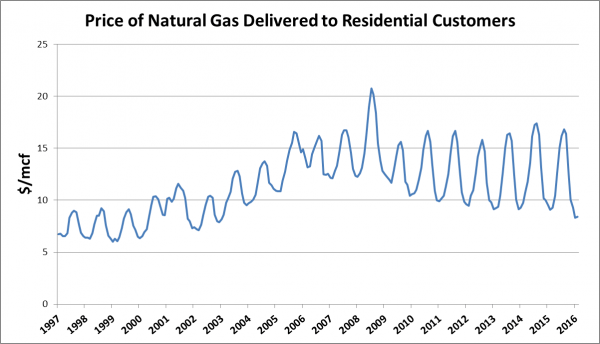Winter is a unique time of the year. From the holidays to the promise of a new year, winter is special in so many ways. Unfortunately, cold weather inevitably leads to higher natural gas bills. We have previously discussed natural gas bill components. However, understanding a few additional elements affecting residential gas rates can be helpful.
Gas Citygate Prices
Most news headlines mentioning natural gas prices refer to wholesale prices. Supply and demand set the prices at national and regional trading hubs. These wholesale prices play a big part in determining what we pay for natural gas. There is another price, however, that more accuratelty reflects what we pay for gas supply charges. This is the citygate price.
The citygate price is the sales price at the point where natural gas transfers from the pipeline to your local gas utility. The citygate price includes the wholesale price of gas as well as the cost of transporting it to your utility through interstate or intrastate pipelines. Citygate prices are especially relevant to us because they reflect local weather and gas usage trends. They also reflect the capacity and congestion of the pipelines serving our area. The U.S. Energy Information Administration compiles and publishes a list of citygate natural gas pricing data by state.
Seasonal Natural Gas Rates
Some natural gas bills show an effective rate on the billing statement. This is simply the total amount due divided by how much natural gas you used. Therefore, it includes the gas supply charges and the delivery charges. Depending on your utility, it may even include any taxes or regulatory charges assessed with your bill. You might notice that your effective rate is significantly higher in the summer than the winter.
One reason for this is that some components of our gas delivery costs are fixed amounts. These are typically metering, billing, and customer charges. When we use less gas in the summer months, those fixed costs are distributed over fewer units of gas. Our monthly bill is much lower in the summer but the effective rate looks abnormally high due to the fixed utility costs.
Source: U.S. Energy Information Administration
The graph above shows another trend that requires explanation. Seasonal natural gas price differences are getting larger in recent years. A study of industry data reveals an increase in citygate prices during the summer. Therefore, fixed delivery charges alone cannot explain this pattern. The most likely cause of this trend is the increased use of natural gas in electricity generation.
Gas-Fired Electricity Generators
As a country, we have made a strong move away from coal-fired power plants to cleaner-burning natural gas. As consumers, we generally use less natural gas in the summer. Power generators, however, use more natural gas in the summer to keep up with cooling demand. This creates a seasonal strain on pipeline systems, especially in the northeast.
Overall, wholesale gas prices are trending downward due to increased production from shale gas deposits. While the country is currently enjoying an oversupply of natural gas, the problem lies with getting it to the power plants. The best solution is to increase pipeline capacity and infrastructure. Energy conservation and a move to renewable power will help in the long term. However, relief in the near term can only come from addressing our pipeline system and making prudent enhancements.




That is such great advice to check out the effective rate on the billing statement for my gas delivery. I didn’t realize the rates can change so frequently and how important to follow those patterns. We are moving into a home and maybe we could buy a larger supply when the rates are lower to save a bit more money. Thanks for the tips!